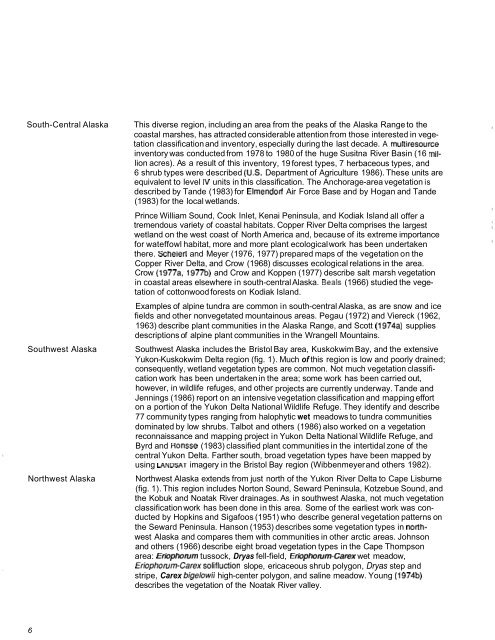The Alaska Vegetation Classification - Alaska Geobotany Center ...
The Alaska Vegetation Classification - Alaska Geobotany Center ...
The Alaska Vegetation Classification - Alaska Geobotany Center ...
You also want an ePaper? Increase the reach of your titles
YUMPU automatically turns print PDFs into web optimized ePapers that Google loves.
South-Central <strong>Alaska</strong>Southwest <strong>Alaska</strong>Northwest <strong>Alaska</strong>This diverse region, including an area from the peaks of the <strong>Alaska</strong> Range to thecoastal marshes, has attracted considerable attention from those interested in vegetationclassification and inventory, especially during the last decade. A multiresourceinventory was conducted from 1978 to 1980 of the huge Susitna River Basin (16 millionacres). As a result of this inventory, 19 forest types, 7 herbaceous types, and6 shrub types were described (US. Department of Agriculture 1986). <strong>The</strong>se units areequivalent to level IV units in this classification. <strong>The</strong> Anchorage-area vegetation isdescribed by Tande (1983) for Elmendoff Air Force Base and by Hogan and Tande(1983) for the local wetlands.Prince William Sound, Cook Inlet, Kenai Peninsula, and Kodiak Island all offer atremendous variety of coastal habitats. Copper River Delta comprises the largestwetland on the west coast of North America and, because of its extreme importancefor wateffowl habitat, more and more plant ecological work has been undertakenthere. Scheierl and Meyer (1976, 1977) prepared maps of the vegetation on theCopper River Delta, and Crow (1968) discusses ecological relations in the area.Crow (1977a. 1977b) and Crow and Koppen (1977) describe salt marsh vegetationin coastal areas elsewhere in south-central <strong>Alaska</strong>. Beak (1966) studied the vegetationof cottonwood forests on Kodiak Island.Examples of alpine tundra are common in south-central <strong>Alaska</strong>, as are snow and icefields and other nonvegetated mountainous areas. Pegau (1972) and Viereck (1962,1963) describe plant communities in the <strong>Alaska</strong> Range, and Scott (1974a) suppliesdescriptions of alpine plant communities in the Wrangell Mountains.Southwest <strong>Alaska</strong> includes the Bristol Bay area, Kuskokwim Bay, and the extensiveYukon-Kuskokwim Delta region (fig. 1). Much of this region is low and poorly drained;consequently, wetland vegetation types are common. Not much vegetation classificationwork has been undertaken in the area; some work has been carried out,however, in wildlife refuges, and other projects are currently underway. Tande andJennings (1986) report on an intensive vegetation classification and mapping efforton a portion of the Yukon Delta National Wildlife Refuge. <strong>The</strong>y identify and describe77 community types ranging from halophytic wet meadows to tundra communitiesdominated by low shrubs. Talbot and others (1986) also worked on a vegetationreconnaissance and mapping project in Yukon Delta National Wildlife Refuge, andByrd and Ronsse (1983) classified plant communities in the intertidal zone of thecentral Yukon Delta. Farther south, broad vegetation types have been mapped byusing LANDSAT imagery in the Bristol Bay region (Wibbenmeyer and others 1982).Northwest <strong>Alaska</strong> extends from just north of the Yukon River Delta to Cape Lisburne(fig. 1). This region includes Norton Sound, Seward Peninsula, Kotzebue Sound, andthe Kobuk and Noatak River drainages. As in southwest <strong>Alaska</strong>, not much vegetationclassification work has been done in this area. Some of the earliest work was conductedby Hopkins and Sigafoos (1951) who describe general vegetation patterns onthe Seward Peninsula. Hanson (1953) describes some vegetation types in northwest<strong>Alaska</strong> and compares them with communities in other arctic areas. Johnsonand others (1966) describe eight broad vegetation types in the Cape Thompsonarea: Eriophorurn tussock, Dryas fell-field, Eriophorum-Carex wet meadow,EriophorunCarexsolifluction slope, ericaceous shrub polygon, Dryas step andstripe, Carex bigelowii high-center polygon, and saline meadow. Young (l974b)describes the vegetation of the Noatak River valley.6
















